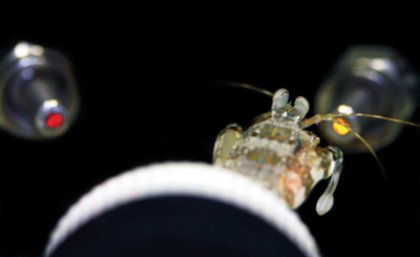
University of Queensland researchers have revealed new insights into colour vision in a study on a tropical reef shrimp.
The study from UQ’s Queensland Brain Institute, crushes the illusion that complex eyes with more colour channels mean better colour vision.
Researcher Hanne Thoen found that the mantis shrimp (Haptosquilla trispinosa),which has 12 colour channels, has worse colour vision than humans, which have three colour channels.
“Theoretically, mantis shrimp should be far better at distinguishing colours than we are,” Ms Thoen said.
“Human brains – and all other animals including birds, monkeys, frogs and fish – determine the colours of objects by comparing the relative excitation of inputs.
“For instance, in humans this is red, green and blue.
“The critical finding is that mantis shrimp do not do this, and this means their way of encoding colour is different to all other animals known.”
A number of tests were conducted, including training the shrimps to respond to certain colours and using a two-way choice test with food as a reward.
Ms Thoen said by receiving food when choosing one particular colour and not any other, the shrimp quickly learned which choice to make and also revealed how they encode colour.
“We tested their ability to discriminate between colours that differ a lot – such as red and blue – and then changed to colours that got closer and closer together along the spectrum – red-green, red-yellow, red-orange – and noted when they started to make mistakes,” Ms Thoen said.
“Results were also compared to a number of other animals, including humans, bees, fish and butterflies, and although theoretically they should be better than all of them, they are far worse.”
Ms Thoen’s PhD supervisor, Professor Justin Marshall, runs the Sensory Neurobiology Group at the Queensland Brain Institute.
He said finding an animal that processed colour vision in a new way was remarkable and totally unexpected.
“It solves a long-standing problem of why mantis shrimp have 12 colour receptors – because they process colours and the contrast they provide in a totally different way to anything we have previously seen in an animal,” Professor Marshall said.
“This is the first time since the original descriptions of colour vision in the 1800s that we are able to say that there is another way of colour processing out there.”
“The findings demonstrate how evolution pushed the design of nervous systems towards a simple arrangement, rather than trying to fully interpret all the information from a very complex colour vision at the retinal level.
“This has the potential to teach us more about humans’ more simplistic perceptions of colour and about bio-inspired machine-vision solutions that might borrow ideas from the evolutionary process.”
Ms Thoen said the discovery would stimulate and inspire the advancement of new and innovative technologies in the applied sciences.
“Modern cameras struggle with the amount of data they take in due to increased pixel numbers.
“Maybe there is a more efficient way and the bio-inspiration provided by the shrimp could be the answer.”
The project was supported by grants from the Asian Office of Aerospace Research and Development, Air Force Office of Scientific Research, Australian Research Council and Doctoral Fellowship (2013) from Lizard Island Research Station – a facility of the Australian Museum.
The study can be accessed here.
Media: Mikaeli Costello, Director Advancement and Communications, Queensland Brain Institute, +61 401 580 685 or mikaeli.costello@uq.edu.au; Professor Justin Marshall, Queensland Brain Institute, +61 7 3345 1397, +61 423 024 162, or justin.marshall@uq.edu.au
The Queensland Brain Institute (QBI) is a world-class research facility based at The University of Queensland’s (UQ) St Lucia campus. Researchers at QBI make great contributions to the field by studying fundamental cellular and mechanistic processes, as well as disorders and diseases from early brain development through to later life. Our scientists work to understand complex functions such as cognition, ageing, neurological disease, mental illness, and learning and memory.
.jpg)











